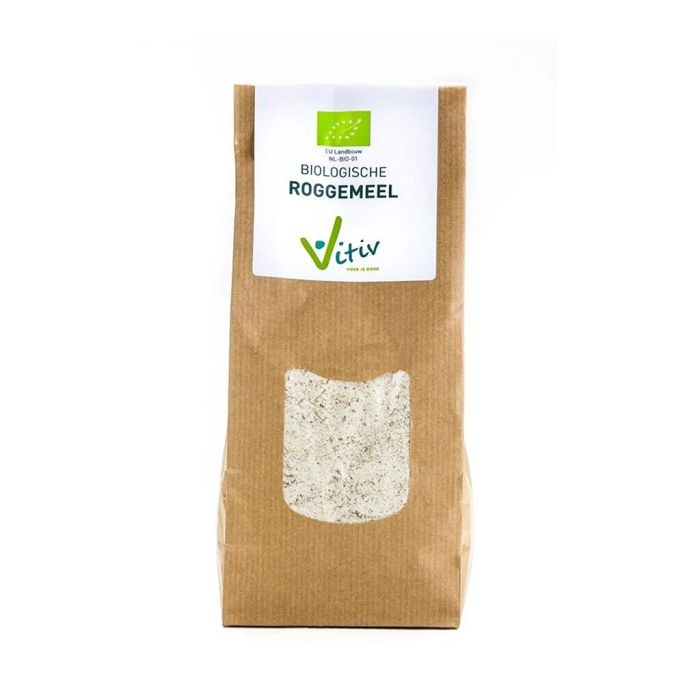This organic rye flour is the ideal growing medium for cultivating mushrooms from a mycelium colony. You can also use it to enrich your agar plates (petri dishes with agar-agar).
Characteristics
- 100% organic rye flour
- Very suitable for cultivating a substrate from which mushrooms can grow
- Mix with vermiculite for added lightness (recommended products)
- Also suitable for enriching agar-agar
- Rye flour contains less gluten than wheat flour
- Nutritional values per 100 grams:
- Energy: 1466 kJ / 349 kcal
- Fat: 1.7 g
- Of which saturated: 0.3 g
- Carbohydrates: 63.6 g
- Of which sugars: 0 g
- Fiber: 11.8 g
- Protein: 10.9 g
- Sodium / Salt: 0 mg
PF-TEK Method?
The PF-TEK method is named after a mushroom cultivation technique developed by Robert McPherson (also known as Psilocybe Fanaticus) in 1991. It remains a popular and simple technique for cultivating magic mushrooms such as Psilocybe cubensis. This method uses a growing medium consisting of vermiculite, brown rice, and water. The mixture is steamed and stored in sterile jars. Liquid culture is then added with a syringe and set to cultivate. The technique is favored for its accessibility, affordability, and relatively low risk of contamination. PF-TEK is ideal for beginners and hobbyists in mushroom cultivation who want to go beyond a ready-made grow kit.
Rye Flour as a Growing Medium for Mushroom Cultivation
Using rye flour to cultivate mushrooms is a powerful choice. Both mushrooms and magic truffles thrive very well on rye flour. However, you should add vermiculite to your rye flour for added airiness and better hydration. The optimal mixture is:
- 2 parts vermiculite
- 1 part rye flour
- 1 part water
What not to do:
Never inject liquid culture directly into a bag of rye flour. Your liquid culture will have no chance for three reasons:
- Rye flour is never delivered sterile. You must sterilize every growing medium and environment before cultivating mushrooms.
- The bag does not breathe enough. Like us, mushrooms inhale oxygen and exhale CO₂.
- The flour must be moist. Mushrooms need water to grow.
We will explain in detail what you should do to successfully grow mushrooms.
How to Cultivate Psilocybe cubensis Substrate with Rye Flour
You will now create a substrate (soil) from a fungal colony from which mushrooms can later grow. These steps outline what you need to do to make the substrate. We will then show you how to produce fruiting bodies (mushrooms).
- Prepare Supplies: Ensure you have a sterile workspace, your successful fungal culture (agar or liquid culture), sterile gloves, a face mask, vermiculite, rye flour, water, and a sterile syringe or inoculation tool. Work extremely sterile, thoroughly disinfect your environment.
- Prepare the Substrate: Mix the rye flour with vermiculite and water in a ratio of 2 parts vermiculite, 1 part rye flour, and 1 part water. Fill a heat-resistant jar or container (preferably with an air filter, micropore tape, or Teflon sticker with a mesh size of up to 0.3 microns) with this mixture.
- Sterilize:
- Place the jars with the rye flour mixture in a pressure cooker, autoclave, or normal pot with a bit of water at the bottom and on a rack or towel to prevent the jars from touching the pot's base.
- Normal Pot: Ensure the pot never runs dry. Cooking time: 60 to 90 minutes.
- Pressure Cooker and Autoclave: Ensure the desired pressure is reached and set a timer. Cooking time: 20 to 30 minutes at 15 PSI (approximately 1.03 bar).
- Cool Down: Let the jars with the substrate cool completely before handling. Never open a hot jar; this prevents contamination.
- Inoculate the Substrate with Liquid Culture:
- Sterilize the liquid culture syringe by heating the needle's tip with a lighter until red-hot. Allow it to cool before injecting the liquid.
- Insert the needle through the top or quickly open the lid and inject in several spots around the mixture's edges. Close the jar immediately.
- Incubate: Place the jar in a warm, dark place (around 21-27°C). Wait until the substrate is fully colonized with mycelium, which may take several weeks. Watch closely for any signs of contamination. Once you see white mycelium forming around the edges, mix the substrate to speed up the process.
From Substrate to Mushrooms
- Tip: Use perlite as a base layer: Sterilize enough perlite (recommended products) to create a base for your substrate. Perlite is excellent for moisture retention and aeration.
- Transfer to a Fruiting Chamber:
- Once colonization is complete, move the substrate to a fruiting chamber (a humid area with sufficient air exchange, such as a large plastic container).
- Maintain high humidity (around 90-95%) and indirect light from above. Spray regularly and ventilate to allow CO₂ to escape. It may take several weeks before mushrooms can be harvested.
Harvesting: When the mushroom caps just begin to separate from the stems, harvest all mushrooms. Twist them gently at the base with clean hands or gloves. Avoid pulling or tearing to prevent damaging the substrate. Then you can rehydrate the substrate with boiled and cooled water to attempt a second flush. Generally, you can cultivate 3 to 4 flushes with the same substrate.
